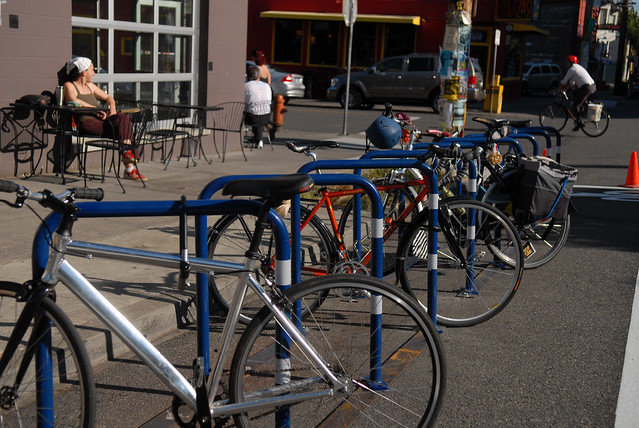Buried in Portland’s new application for $2.5 million to expand its proposed bike sharing system into Portland’s eastside neighborhoods is a bit of analysis worth noting.
According to modeling prepared early last year by Alta Bicycle Share, the commercial spine of the 20s bikeway project, between NE Sandy and SE Clinton, is cut out to be one of the city’s best areas for bicycle sharing outside downtown.
It’s a calculation that raises the stakes somewhat for this much-discussed project, since a successful bike share system depends on creating bikeways that appeal to people who don’t frequently ride.
Alta’s models, which are informed by five years of usage data from cities that have bike sharing, are based on the density of jobs, residents, transit service, intersections and relatively flat terrain.
Based on those factors, Alta figured that ideal places for bike share stations would be the intersections of 28th, 27th and 26th avenues with Glisan, Burnside, Stark, Belmont, Hawthorne and Clinton. That’d be enough to make the district one of the biggest bike sharing hubs east of the Willamette, even better-suited to bike sharing trips than spots like North Mississippi, Northeast Alberta and Southeast Division.

Though bike sharing stations require street space, they increase a street’s total parking capacity, since 11 bike parking spots take up the space required for two car parking spots.
In a 2011 survey of members of Washington DC’s Capital Bikeshare, 82 percent said they’re more likely to patronize businesses near bike share stations.
City bikeshare specialist Steve Hoyt-McBeth noted that the station mapping used in the new grant application (made public by Willamette Week) was “Alta’s exercise” and hasn’t been discussed by city planners.
“If awarded the Connect Oregon grant, bike share would serve these neighborhood commercial districts, but the actual station locations have not been determined,” Hoyt-McBeth wrote in an email Monday. “There will be many factors that determine the actual location of bike share stations.”
Here’s a PDF of the city’s grant application to the state’s highly competitive Connect Oregon program.
A station that holds up to 11 shared bicycles is about 40 feet long. If the city can secure a private sponsor, something Commissioner Steve Novick suggested might be announced “hopefully within the next six weeks” in a conversation with the Mercury last week, it hopes to find locations for about 75 stations around the city, mostly in the downtown area, holding 750 shared bikes.
That’d be the first phase of bike sharing in Portland. The city’s new grant proposal would make the second phase possible: another 30 stations and 300 bikes, mostly in neighborhood commercial districts on the near east side — including the 28th Avenue area.
If approved, the bike sharing expansion could take some pressure off the rising demand for on-street auto parking in the area, because people who live in the big apartments going up nearby would be able to bike almost anywhere in the central city for free as long as they own a bikeshare membership. As we reported in September, memberships are likely to cost about $75 a year.
It will be interesting to see how/if the expected Portland bike share system will impact planning decisions on major projects like the 20s bikeway. Stay tuned.
Correction 12:30 pm: An earlier version of this post misstated the number of cars that can park in a 40-foot space.

